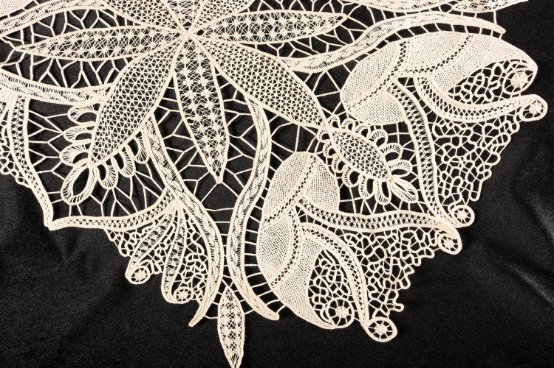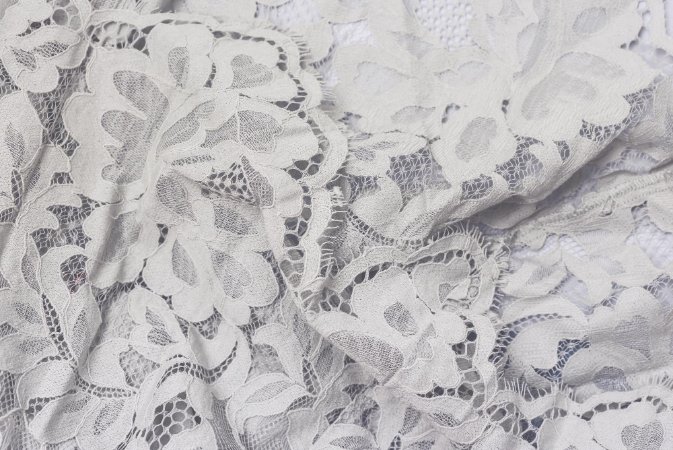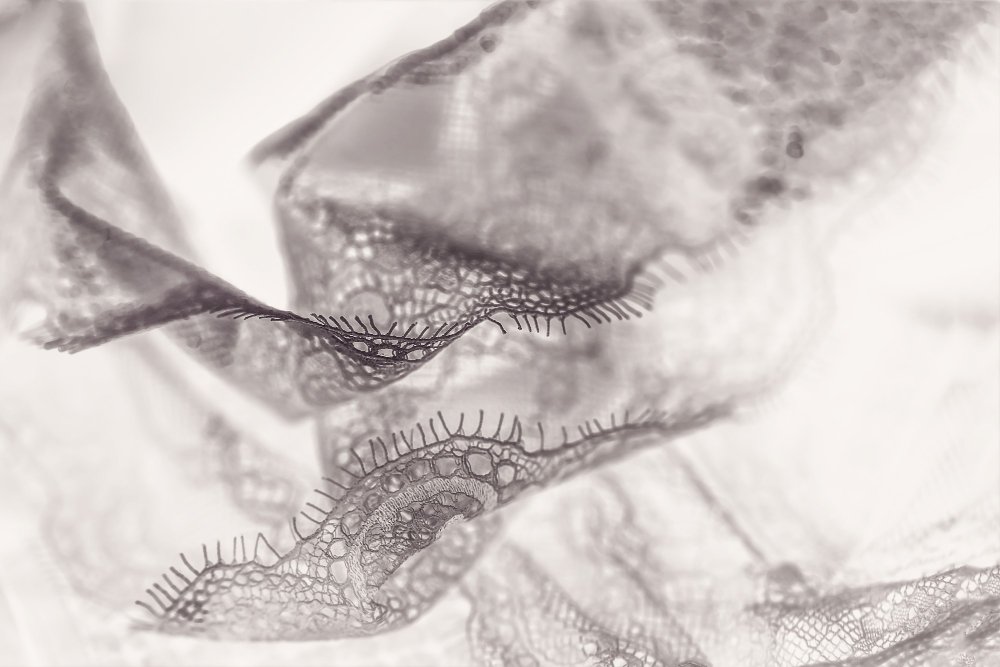Discover the timeless elegance of Renaissance lace through centuries of craftsmanship and modern innovation
Table of Contents
- Introduction to Renaissance Lace
- Historical Origins and Development
- Renaissance Lace Timeline
- Traditional Techniques and Construction
- Identification Guide
- Types and Regional Variations
- Materials and Fabric Specifications
- Renaissance Clothing and Style
- Modern Applications and Uses
- Care and Preservation
- Professional Buying Guide
- Frequently Asked Questions
- Conclusion
Introduction to Renaissance Lace
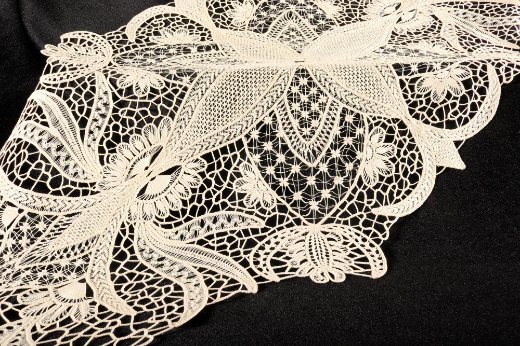
Renaissance lace fabric represents one of history’s most exquisite textile achievements. This delicate, openwork fabric emerged during Europe’s cultural rebirth in the late 15th and early 16th centuries, transforming from simple decorative elements into symbols of wealth, artistry, and social status.
Understanding Renaissance lace requires appreciating both its historical significance and modern applications. From the noble courts of Italy and Flanders to today’s fashion runways and interior design studios, this remarkable textile continues to captivate creators and collectors worldwide.
The term “Renaissance lace” specifically refers to tape lace techniques that flourished during the Renaissance period, though the broader category includes various lace fabric styles that emerged during this transformative era.
Historical Origins and Development
Pre-Renaissance Foundations
Before true lace emerged, artisans worked with drawn-thread techniques and cutwork embroidery. These early methods involved removing threads from woven fabric and securing the remaining structure with decorative stitching. While beautiful, these techniques remained bound to their fabric foundations.
The Birth of True Lace
The revolutionary breakthrough came when craftspeople freed their work from woven foundations entirely. This innovation allowed for the creation of independent, openwork fabrics that could be shaped into any desired pattern. Two distinct approaches emerged simultaneously: needle lace in Italy and bobbin lace in Flanders (modern-day Belgium).
Regional Development Centers
Venice became the epicenter of needle lace innovation, developing the famous “Punto in Aria” (stitches in the air) technique. Meanwhile, Flemish artisans perfected bobbin lace methods that allowed for faster production while maintaining intricate beauty.
France later established itself as a major lace center, particularly excelling in Alençon lace and other sophisticated styles that combined the best elements of Italian and Flemish traditions.
Renaissance Lace Timeline
Traditional Techniques and Construction
Needle Lace Method
Needle lace construction begins with a detailed pattern drawn on parchment. Artisans lay foundation threads along the pattern lines, then build the lace structure using a single thread and needle. The process requires exceptional skill, with each mesh completed individually before moving to the next.
Needle Lace Characteristics
- Single thread construction
- Buttonhole stitch foundation
- Highly detailed patterns possible
- Slower production process
- Often more valuable than bobbin lace
Bobbin Lace Characteristics
- Multiple thread construction (20+ bobbins)
- Plaiting and twisting techniques
- Faster production than needle lace
- Excellent for geometric patterns
- More commercially viable
Renaissance Tape Lace Evolution
The specific technique known as Renaissance lace evolved from earlier tape lace methods, where pre-made tapes were arranged in patterns and connected with delicate stitching. This approach allowed for more efficient production while maintaining the appearance of complex lace construction.
Modern Renaissance lace continues this tradition, often combining machine-made tapes with hand-finished connecting work, making it more accessible to contemporary crafters while preserving historical aesthetics.
Watch how historical Renaissance lace techniques are recreated using modern digitization methods for authentic Italian camicia construction.
Identification Guide
How to Identify Authentic Renaissance Lace
Renaissance Lace Identification Process
Examine Construction Method → Check Thread Quality → Analyze Pattern Complexity → Assess Age IndicatorsVisual Identification Markers
| Feature | Handmade Renaissance Lace | Machine-Made Reproductions |
|---|---|---|
| Thread Tension | Slight variations, natural irregularities | Perfectly uniform tension throughout |
| Pattern Connections | Hand-stitched joins, visible needle marks | Seamless machine connections |
| Edge Finishing | Soft, slightly irregular edges | Sharp, precisely cut edges |
| Tape Curves | Natural flowing curves around corners | Folded kinks at direction changes |
| Thread Ends | Carefully woven in and hidden | May show cut ends or loose threads |
Types and Regional Variations
Major Renaissance Lace Categories
| Type | Origin | Key Features | Best For |
|---|---|---|---|
| Punto Tagliato | Italy | Cutwork with needle lace fills | Altar cloths, table linens |
| Reticella | Italy | Geometric drawn-thread work | Formal garment trim |
| Punto in Aria | Venice | Free-standing needle lace | Luxury accessories |
| Flemish Bobbin | Flanders | Multiple thread plaiting | Commercial production |
| Renaissance Tape | Various | Connected tape construction | Modern reproductions |
Related Lace Styles
Renaissance lace techniques influenced many later developments, including Chantilly lace, Guipure lace, and Cluny lace. Understanding these connections helps appreciate the evolution of lace-making throughout European history.
Materials and Fabric Specifications
Traditional Renaissance Materials
Historical Renaissance lace used premium natural fibers that were both beautiful and durable. The choice of material often indicated the intended use and social status of the wearer.
| Material | Characteristics | Historical Use | Modern Availability |
|---|---|---|---|
| Linen Thread | Strong, ages beautifully | Most common Renaissance choice | Available from specialty suppliers |
| Silk Thread | Lustrous, delicate handling | Luxury items, court dress | High-end reproductions |
| Gold/Silver Wire | Metallic brilliance | Religious vestments, royal garments | Museum restorations only |
| Cotton Thread | Soft, washable | Later period, everyday items | Most modern reproductions |
Modern Synthetic Options
Contemporary Renaissance lace often incorporates synthetic fibers for improved durability and care. Natural vs synthetic fabric choices depend on intended use, with synthetic blends offering practical advantages for everyday items while pure natural fibers remain preferred for historical accuracy.
Renaissance Clothing and Style
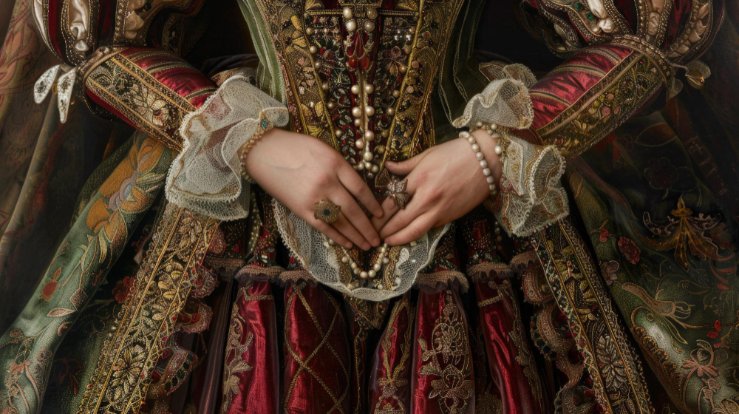
What Was Renaissance Clothing Made Of?
Renaissance clothing combined multiple luxury materials to create stunning visual effects. The wealthy adorned themselves in silk, velvet, and brocade as base fabrics, enhanced with intricate lace trim and embellishments. Common fabric types of the era included heavy wools for outer garments and fine linens for undergarments.
Renaissance Style Clothing Characteristics
Renaissance fashion emphasized structural silhouettes and rich surface decoration. Key characteristics included:
Women’s Renaissance Style
- Fitted bodices with corseted waists
- Full skirts supported by farthingales
- Elaborate sleeve designs with slashing
- Extensive lace trim on collars and cuffs
- Rich fabrics like silk and velvet
Men’s Renaissance Style
- Doublets with padded chests
- Hose or breeches for lower body
- Elaborate ruffs around the neck
- Decorative codpieces (early period)
- Cloaks and robes for formal occasions
What Defines Renaissance Style?
Renaissance style represents a dramatic shift from medieval simplicity to ornate sophistication. The period emphasized human beauty, artistic expression, and conspicuous display of wealth. Clothing became a canvas for showcasing the finest materials, most skilled craftsmanship, and latest fashion innovations from across Europe.
Renaissance vs Medieval Fashion
While medieval and Renaissance periods are closely related chronologically, their fashion aesthetics differ significantly. Medieval clothing prioritized function and religious modesty, while Renaissance fashion celebrated human form and artistic achievement. The transition marked Europe’s emergence from the “Dark Ages” into a period of cultural flowering.
Follow the creation process of an authentic Renaissance gown, showcasing traditional construction methods and fabric choices.
Social Fabrics of the Renaissance
Renaissance society was literally woven together by textile production and trade. Lace-making provided income for countless women across Europe, from noble ladies pursuing genteel pastimes to professional artisans supporting their families. The textile trade connected Italian silk producers with Flemish lace makers and French fashion centers, creating one of history’s first truly international luxury markets.
Modern Applications and Uses
Contemporary Fashion Applications
Bridal and Evening Wear
Renaissance lace continues to dominate luxury fashion markets, particularly in bridal collections. Modern designers appreciate its romantic aesthetic and historical significance, often combining traditional techniques with contemporary silhouettes.
High Fashion and Couture
Leading fashion houses regularly feature Renaissance-inspired lace in their collections. The intricate patterns and handcrafted quality align perfectly with couture values of exceptional artistry and exclusivity.
Lingerie and Intimate Apparel
The delicate nature of Renaissance lace makes it ideal for luxury lingerie. Modern production methods create stretch lace variations that maintain historical aesthetics while providing contemporary comfort and fit.
Interior Design Applications
Window Treatments
Renaissance lace creates stunning curtain panels that filter light beautifully while maintaining privacy. The historical patterns add elegance to both traditional and contemporary interiors.
Table Linens and Accessories
Tablecloths, runners, and placemats featuring Renaissance lace patterns bring sophisticated elegance to dining spaces. These pieces work particularly well for formal entertaining and special occasions.
Decorative Accents
Throw pillows, wall hangings, and upholstery details incorporating Renaissance lace add textural interest and historical character to interior spaces.
Innovative Modern Uses
Technology has opened new applications for Renaissance lace patterns. Laser-cutting techniques can reproduce intricate designs in various materials, while digital printing allows for lace-inspired patterns on fabrics that couldn’t traditionally support lace construction.
Care and Preservation
Professional Care Guidelines
Cleaning Renaissance Lace
Proper care is essential for preserving Renaissance lace, whether antique or modern reproduction. The delicate nature of the construction requires gentle handling and appropriate cleaning methods.
Lace Cleaning Process
Assess Condition → Test Cleaning Method → Gentle Hand Washing → Proper Drying → Careful StorageStep-by-Step Cleaning Instructions
- Pre-cleaning Assessment: Examine the lace for weak areas, stains, or damage that might worsen during cleaning.
- Gentle Hand Washing: Use lukewarm water with pH-neutral detergent. Never use bleach or harsh chemicals on historical lace.
- Soaking Method: Allow heavily soiled pieces to soak briefly, but never leave delicate lace submerged for extended periods.
- Rinse Thoroughly: Use multiple clean water rinses to remove all detergent residue.
- Drying Process: Lay flat on clean towels, reshaping gently while damp. Never wring or twist lace fabric.
Storage and Preservation
| Storage Method | Best For | Materials Needed | Avoid |
|---|---|---|---|
| Flat Storage | Fragile antique pieces | Acid-free boxes, tissue paper | Direct folding |
| Rolling Storage | Long lace lengths | Acid-free tubes, muslin covers | Tight rolling |
| Hanging Storage | Modern lace garments | Padded hangers, garment bags | Wire hangers |
| Climate Control | All lace types | Stable temperature/humidity | Plastic containers |
Environmental Factors
Proper environmental conditions are crucial for long-term preservation. Maintain consistent temperature (65-70°F) and relative humidity (45-55%). Protect from direct sunlight, which can fade colors and weaken fibers over time.
Professional Buying Guide
Quality Assessment Checklist
Whether purchasing antique Renaissance lace or modern reproductions, certain quality indicators help ensure value and authenticity.
Antique Renaissance Lace
- Provenance documentation when possible
- Consistent with period construction methods
- Natural aging patterns in fibers
- Hand-finished edges and connections
- Appropriate wear patterns for age
- Expert authentication recommended
Modern Renaissance Lace
- Quality of base materials and threads
- Precision of pattern reproduction
- Durability of construction methods
- Colorfastness and care requirements
- Manufacturer reputation and warranties
- Appropriate pricing for quality level
Price Point Expectations
Renaissance lace pricing varies dramatically based on age, condition, rarity, and construction method. Understanding market ranges helps make informed purchasing decisions.
| Category | Price Range | Typical Uses | Investment Potential |
|---|---|---|---|
| Museum-Quality Antique | $500-$10,000+ | Collection, display | High |
| Vintage Handmade | $50-$500 | Restoration projects, study | Moderate |
| High-Quality Reproduction | $20-$100 | Crafting, costume, decor | Utility value |
| Commercial Machine-Made | $5-$25 | Everyday projects | Utility value |
Vendor Evaluation Criteria
Choosing reputable suppliers ensures quality and authenticity. Look for vendors who provide detailed descriptions, accurate photographs, and clear return policies. Established dealers often have relationships with textile experts and can provide authentication services.
Frequently Asked Questions
Conclusion
Renaissance lace fabric represents one of humanity’s most enduring artistic achievements, bridging centuries of craftsmanship with contemporary creativity. From its revolutionary origins in 15th-century Italy and Flanders to today’s innovative applications in fashion and interior design, this remarkable textile continues to captivate and inspire.
The historical significance of Renaissance lace extends far beyond mere decoration. It represents a pivotal moment when European artisans freed themselves from traditional constraints, developing techniques that transformed simple threads into complex, beautiful fabrics. The social and economic impact was equally profound, providing livelihoods for countless artisans while serving as symbols of wealth, status, and artistic appreciation.
Understanding Renaissance lace requires appreciating both its technical complexity and cultural context. The distinction between needle lace and bobbin lace techniques, the evolution from cutwork to independent fabric construction, and the regional variations across Europe all contribute to the rich tapestry of lace history. Modern collectors and creators benefit from this knowledge when evaluating authenticity, planning projects, or simply appreciating the artistry involved.
Contemporary applications demonstrate the timeless appeal of Renaissance lace aesthetics. Whether in haute couture fashion, luxury home décor, or innovative architectural applications, the patterns and techniques developed centuries ago continue to provide inspiration and practical solutions. The integration of traditional methods with modern materials and production techniques ensures that Renaissance lace remains relevant and accessible to new generations of artisans and enthusiasts.
Essential Takeaways
- Historical Authentication: True Renaissance lace shows hand-construction techniques, natural fiber aging, and period-appropriate construction methods. Professional authentication is crucial for valuable pieces.
- Care and Preservation: Proper care involves gentle hand washing, flat drying, and appropriate storage in stable environmental conditions. Antique pieces require professional conservation.
- Modern Applications: Renaissance lace continues to influence contemporary fashion, interior design, and artistic expression, proving its enduring aesthetic appeal.
- Quality Investment: Whether purchasing antique pieces or modern reproductions, understanding construction methods, materials, and market values ensures wise investments.
- Cultural Legacy: Renaissance lace represents not just textile artistry but European cultural transformation, making it valuable for historical study and appreciation.
Professional Recommendations
For Collectors: Focus on provenance, condition, and authenticity. Build relationships with reputable dealers and consider pieces for both investment and historical significance. Document your collection thoroughly for insurance and heritage purposes.
For Creators and Designers: Study historical techniques to understand construction principles, but don’t hesitate to adapt methods for contemporary needs. High-quality reproductions often provide the best balance of authenticity and practicality for most projects.
For Fashion Professionals: Renaissance lace offers timeless elegance that transcends fashion trends. Consider it for special occasion wear, luxury collections, and projects requiring historical accuracy or romantic aesthetics.
For Interior Designers: Use Renaissance lace selectively as accent pieces rather than dominant elements. The intricate patterns work best when they can be appreciated without overwhelming the overall design scheme.
The future of Renaissance lace lies in balancing preservation of traditional techniques with innovation in materials and applications. As we continue to appreciate handcrafted artistry in an increasingly digital world, Renaissance lace serves as a tangible connection to our cultural heritage while inspiring new creative possibilities.
Whether you’re drawn to Renaissance lace for its historical significance, artistic beauty, or practical applications, understanding its rich heritage enhances appreciation and ensures appropriate care and use. This remarkable textile tradition continues to evolve while maintaining its essential character, proving that true artistry transcends time and trends.
External References and Further Reading
- Victoria and Albert Museum – Textiles Collection
- Metropolitan Museum of Art – Textile Production in Europe: Lace, 1600–1800
- Encyclopedia Britannica – Lace Art and History
This comprehensive guide serves as an introduction to Renaissance lace fabric. For specific restoration projects, valuable antique pieces, or professional applications, always consult with qualified textile experts and conservators.

